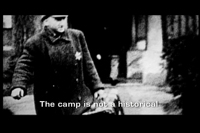
Camp
Peter Freund - 2011, 7:00, 35mm, 16mm, video (various), Forestville, CA
This experimental short juxtaposes the political and theatrical senses of “camp” as a metaphor for our contemporary cultural deadlock between two post-modernist sensibilities. Guiding this split (parallax) vision, two narrative voices (one in Chinese, the other in Arabic) mix venerated cultural statements with original commentary, while factual and fictive footage provide support, context, and counterpoint. In Arabic, Chinese, and English.

Peter Freund is a multimedia artist and scholar based in the San Francisco Bay Area. He works with the moving image, sound, text, and interactive media, exploring questions of alterity (or ‘otherness’) in its psychological and political dimension. He has exhibited internationally, including in the U.S., Latin America, Europe, Australia, and the Middle East. Freund is Associate Professor of Art Practice at Saint Mary's College of California, where he teaches media art practice and critical theory.
Questions & Answers
ATA: At the end of the piece, you inform us of the cited texts and footage. These are all careful choices. I'm curious how you came to make these particular choices and assemble them in this particular way.
PF: Admittedly, “Camp” springs from an absurd, almost obscene conceit. After all, how can the idea of the death camp be put on the same screen as the campy? (No doubt a Mel Brooks-inspired video awaits us on youtube.) Following this arbitrary, utterly contingent coincidence of the word “camp,” the sketchy patchwork of low, middle, and high-brow sources I assembled stumbles toward a question: Is there a connection between the somber lockjaw of post-death-camp ethics and the evasive, theatrical ornament of campiness? Could these two positions in fact be flip sides of the same aesthetic, the dominant aesthetic in which we live today? Pasolini’s Salò, which appears late in “Camp,” already presented perhaps the most eloquent and horrifying bridge between fascism and the contemporary injunction to enjoy. …But what else?
ATA: Can you tell us about the use of the refrain "I close. I open"?
PF: The refrain repurposes the figure of the “Opener” from Samuel Beckett’s “Cascando.” First of all, the refrain offers a nice, simple structuring device for the central juxtaposition in “Camp.” Beyond that, following Beckett, the opener stands in for a kind of brute agency (beyond author, character, narrator, or even editor or projectionist) that implicitly operates the contingent flow of image and sound. There’s apparently nothing in its head, it resents the suggestion that it represents anything, it just opens and closes media like a water faucet. It oscillates like an unconscious drive.
ATA: Is there anything I should have asked you or anything else you'd like to let us know? Any current or upcoming projects of particular interest?
PF: I’m working on a three-channel video installation. Ostensibly about the end of the Red Scare period in the U.S., the piece is narrated as a forced confession from contemporary Iran.
Q&A by Liz Wing



